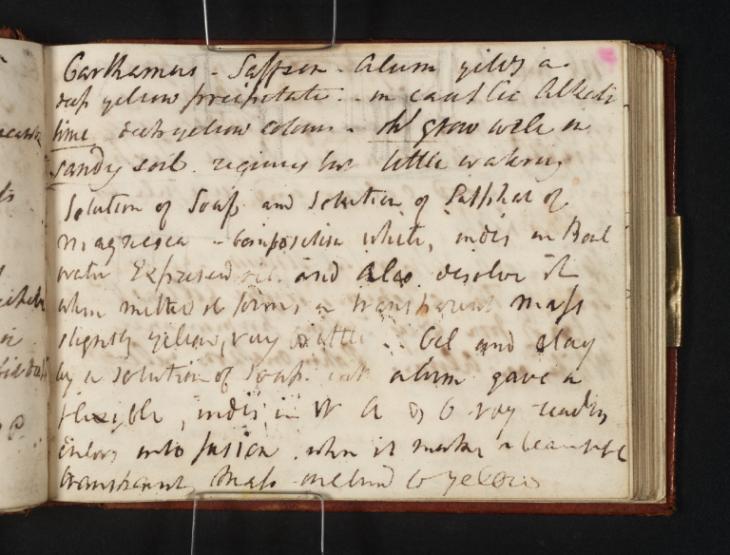The whole page is taken up with notes on chemistry in relation to colour:
Carthamus – Saffron – Alum yilds [sic] a | deep yellow precipitate. in caustic Alkali | lime deep yellow colour. [?W] grow well in | sandy soil. requires but little watering
Solution of Soap and Solution of Sulphat of | Magnesia – composition white indis in Boil | water Expressed oil and alco disolve [sic] it | when melted it forms a transparent mass | slightly yellow, very brittle. Oil and clay | by a solution of soap with alum gave a | flexible, indis in W A & O very readily | Enters into fusion when it makes a beautiful | transparent mass inclind to yellow
Without establishing their origin, Joyce Townsend interprets these notes as concerning the making of ‘yellow organic pigments’ by: ‘growing the plant, treating the relevant part, precipitating the dye onto a claybase, ie forming a laked pigment’.
1This is one of fourteen pages of notes on varnishes and colours resulting from chemical reactions between folio 62 verso (
D09974) and folio 55 recto (
D09959), working from the back of the sketchbook as now foliated. As discussed in the sketchbook’s Introduction,
2 most are taken from William Nicholson’s 1808
Dictionary of Practical and Theoretical Chemistry, here beginning with the unpaginated entry on ‘Saffron (Bastard)’:
Alum forms with it a deep yellow precipitate in small quantity.
... If these flowers be put into a solution of caustic alkali, they become yellow, and the and the liquor which is pressed out is of a deep yellow colour.
Turner’s comments on soil and watering seem to be his own gloss on Nicholson’s lengthy description of the cultivation of saffron in Egypt and elsewhere. The next notes are from Nicholson’s entry on ‘Soap’:
The mixture of a solution of soap and a solution of sulphat of magnesia afforded a combination of the utmost whiteness. It is unctuous, dries with difficulty, and preserves its white colour after desiccation. It is insoluble in boiling water, but has nevertheless a decided taste of soap. Expressed oil, as well as alcohol, dissolves it in considerable Quantity. When water is added to the solution in the latter fluid, it becomes milky. This combination melts with a moderate heat, and forms a transparent mass, slightly yellow, and very brittle. ...
Oil was combined with clay by mixing a solution of alum with a solution of soap. The result of this mixture was a flexible combination, soft to the touch, which preserves its suppleness and tenacity in drying. It appeared to be insoluble in water, alcohol, and oil. It very readily enters into fusion, after which it exhibits a mass of a beautiful transparency, inclined to yellow.
There are further notes from the ‘Soap’ entry on the recto (
D09961). The present notes are written over two small pencil diagrams, which may be architectural plans. One is at the top centre, and is basically a broad ‘T’ form with internal divisions; the second is towards the centre left, and is an inverted ‘L’ shape.

